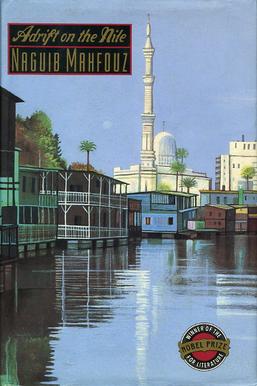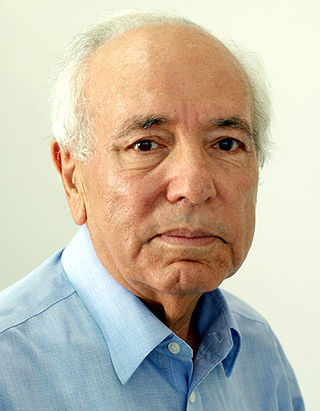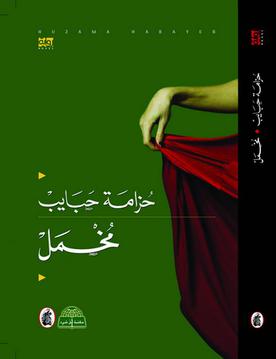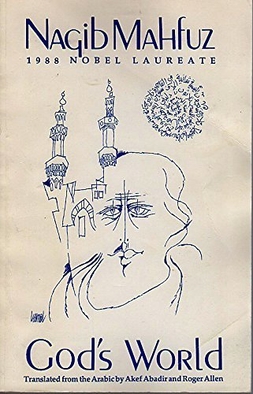
Naguib Mahfouz Abdelaziz Ibrahim Ahmed Al-Basha was an Egyptian writer who won the 1988 Nobel Prize in Literature. In awarding the prize, the Swedish Academy described him as a writer "who, through works rich in nuance – now clear-sightedly realistic, now evocatively ambiguous – has formed an Arabian narrative art that applies to all mankind". Mahfouz is regarded as one of the first contemporary writers in Arabic literature, along with Taha Hussein, to explore themes of existentialism. He is the only Egyptian to win the Nobel Prize in Literature. He published 35 novels, over 350 short stories, 26 screenplays, hundreds of op-ed columns for Egyptian newspapers, and seven plays over a 70-year career, from the 1930s until 2004. All of his novels take place in Egypt, and always mention the lane which equals the world. His most famous works include The Cairo Trilogy and Children of Gebelawi. Many of Mahfouz's works have been made into Egyptian and foreign films; no Arab writer exceeds Mahfouz in number of works that have been adapted for cinema and television. While Mahfouz's literature is classified as realist literature, existential themes appear in it.

The Journey of Ibn Fattouma is an intermittently provocative fable written and published by Nobel Prize-winning author Naguib Mahfouz in 1983. It was translated from Arabic into English in 1992 by Denys Johnson-Davies and published by Doubleday.
Denys Johnson-Davies was an eminent Arabic-to-English literary translator who translated, inter alia, several works by Nobel Prize-winning Egyptian author Naguib Mahfouz, Sudanese author Tayeb Salih, Palestinian poet Mahmud Darwish, and Syrian author Zakaria Tamer.
Islamic literature is literature written by Muslim people, influenced by an Islamic cultural perspective, or literature that portrays Islam. It can be written in any language and portray any country or region. It includes many literary forms including adabs, a non-fiction form of Islamic advice literature, and various fictional literary genres.
Bensalem Himmich is a Moroccan novelist, poet and philosopher with a PhD in Philosophy from the University of Paris, who teaches at the Mohammed V University, Rabat. He served as Minister of Culture from 29 July 2009 to 3 January 2012.

Midaq Alley is a 1947 novel by Egyptian author Naguib Mahfouz, first published in English in 1966. The story is about Midaq Alley in Khan el-Khalili, a teeming back street in Cairo which is presented as a microcosm of the world.
Sahar Khalifeh is a Palestinian writer. She has written eleven novels, which have been translated into English, French, Hebrew, German, Spanish, and many other languages. One of her best-known works is the novel Wild Thorns (1976). She has won international prizes, including the 2006 Naguib Mahfouz Medal for Literature, for The Image, the Icon, and the Covenant. Khalifeh obtained her Bachelor of Arts degree in English from Birzeit University, Palestine.

Adrift on the Nile is a 1966 book by Egyptian author and Nobel Laureate Naguib Mahfouz. The novel was later made into a 1971 film, Chitchat on the Nile. It was translated from Arabic into English in 1993 by Frances Liardet and published by Doubleday.

Sasson Somekh was an Iraqi-Israeli academic, writer and translator. He was professor emeritus of Modern Arab Literature at Tel Aviv University.

The American University in Cairo Press is the leading English-language publisher in the Middle East.

The Naguib Mahfouz Medal for Literature is a literary award for Arabic literature. It is given to the best contemporary novel written in Arabic, but not available in English translation. The winning book is then translated into English, and published by American University in Cairo Press. It was first awarded in 1996 and is presented annually on December 11, the birthday of Nobel laureate Naguib Mahfouz, by the President of the American University in Cairo.
Trevor LeGassick was a noted Western scholar and translator in the field of Arabic literature. He obtained a BA in Arabic from the School of Oriental and African Studies in 1958 and completed a PhD, also from SOAS, in 1960. After stints in Wisconsin and Indiana, he joined the faculty of the University of Michigan in 1966, where he would teach for fifty-two years. He was promoted to full professor in 1979.
The Project of Translation from Arabic is an academic project initiated by Dr Salma Khadra Jayyusi in 1980 in order to translate, and publish, works of Arabic literature into the English language. The stated goal of PROTA is "the dissemination of Arabic culture and literature abroad". The project had its genesis in the late 1970s when Columbia University Press invited Jayyusi to prepare a large anthology of modern Arabic literature. Funding came from the Iraqi Ministry of Information and Culture. Two major anthologies came out of this early endeavour: Modern Arabic Poetry (1987) and The Literature of Modern Arabia (1988).

Huzama Habayeb ) is a Palestinian novelist, storyteller, columnist, translator, and poet who has won multiple awards such as the Mahmoud Seif Eddin Al-Erani Award for Short Stories, Jerusalem Festival of Youth Innovation in Short Stories, and Naguib Mahfouz Medal for Literature. Upon graduating from Kuwait University in 1987 with a Bachelor of Arts in English language and Literature, she pursued careers in journalism, teaching, and translation before she eventually started to write professionally as a published author. She is a member of both the Jordanian Writers Association and the Arab Writers Federation.

Velvet is an Arabic language novel by Palestinian author Huzama Habayeb published in 2016. The book won the Naguib Mahfouz Medal for Literature in 2017. The novel depicts several Palestinian women experiencing tragic love stories under the compelling circumstances and within the ultraconservative community of Baqa'a refugee camp in Jordan.
Fawzia Abd Al-Minem Al-Ashmawi is an Egyptian academic, writer and translator. She works as a Professor of Arabic Literature and Islamic Civilisation in the University of Geneva. She had won the Golden Award in Sciences and Arts from Egypt.
Hussein Eid is an Egyptian writer, born in Cairo, got a bachelor's degree in commerce. He has several books in fiction and novel and he has significant books in literary translation. For the past two decades he was specialized in criticism and has 13 books such as and.
Whisper of Madness is Naguib Maḥfouz’s first short story collection. It consists of short stories taking place in Cairo, following the scandals of Cairo's elite and its underbelly, with nationalism persisting throughout the collection. The stories were first published separately in newspapers and magazines in the 1930s. The short story The Price of Weakness is considered to be Maḥfouz’s first short story, and it was published in August 1934. Maḥfouz clears some misconceptions about the collection by saying “readers might not be aware that Whisper of Madness was not published in 1938, as is stated in my bibliography, but actually after the publication of my novel ‘Midaq Alley’’.

God's World is a short story collection by the Egyptian writer Naguib Mahfouz. The collection consists of fourteen stories, long and short. In his collection, Mahfouz takes the reader through Al-Ḥusayn suburbs and Al-'Abbasiyya streets before stopping on Alexandria’s beach and passing through the cemeteries before taking them to a wedding, leading out of a mosque, and finally heading to a bar. This short story collection acts as a lens, clarifying reality. He presents the lives of people from all classes, using aesthetics and concise language. The stories in the collection were published separately in Al-Ahram newspaper between 1961-1962, and they present causes and visions relevant to the 1950s and early 1960s. ‘God’s World’ was published after 25 years after the publication of Mahfouz's first short story collection ‘Hams Al-Junun' or ‘Whisper of Madness.’ During the period between these two collections, Mahfouz had already established himself as a novelist, for some of his most notable novels were published during that period, like ‘Autumn Quail’ and ‘Medaq Alley.’ It is believed that his becoming a member of Al-Ahram's editorial team drove him to pick up his interest in short stories once more.

The 1988 Nobel Prize in Literature was awarded to the Egyptian writer Naguib Mahfouz (1911–2006) "who, through works rich in nuance – now clear-sightedly realistic, now evocatively ambiguous – has formed an Arabian narrative art that applies to all mankind." He is the first and only Arabic–Egyptian recipient of the prize.









